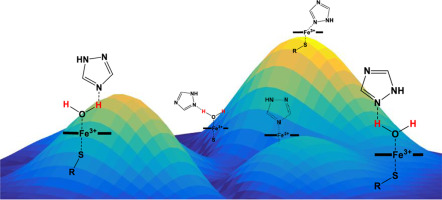Journal of Inorganic Biochemistry ( IF 3.9 ) Pub Date : 2018-02-24 , DOI: 10.1016/j.jinorgbio.2018.02.021 Molly M. Lockart , Carlo A. Rodriguez , William M. Atkins , Michael K. Bowman

|
Cytochrome P450 (CYP) monoxygenses utilize heme cofactors to catalyze oxidation reactions. They play a critical role in metabolism of many classes of drugs, are an attractive target for drug development, and mediate several prominent drug interactions. Many substrates and inhibitors alter the spin state of the ferric heme by displacing the heme's axial water ligand in the resting enzyme to yield a five-coordinate iron complex, or they replace the axial water to yield a nitrogen-ligated six-coordinate iron complex, which are traditionally assigned by UV–vis spectroscopy. However, crystal structures and recent pulsed electron paramagnetic resonance (EPR) studies find a few cases where molecules hydrogen bond to the axial water. The water-bridged drug-H2O-heme has UV–vis spectra similar to nitrogen-ligated, six-coordinate complexes, but are closer to “reverse type I” complexes described in older liteature. Here, pulsed and continuous wave (CW) EPR demonstrate that water-bridged complexes are remarkably common among a range of nitrogenous drugs or drug fragments that bind to CYP3A4 or CYP2C9. Principal component analysis reveals a distinct clustering of CW EPR spectral parameters for water-bridged complexes. CW EPR reveals heterogeneous mixtures of ligated states, including multiple directly-coordinated complexes and water-bridged complexes. These results suggest that water-bridged complexes are under-represented in CYP structural databases and can have energies similar to other ligation modes. The data indicates that water-bridged binding modes can be identified and distinguished from directly-coordinated binding by CW EPR.
中文翻译:

CW EPR参数揭示细胞色素P450配体结合模式
细胞色素P450(CYP)单加氧酶利用血红素辅因子催化氧化反应。它们在许多类药物的新陈代谢中起关键作用,是药物开发的有吸引力的目标,并介导了几种重要的药物相互作用。许多底物和抑制剂通过置换静止酶中血红素的轴向水配体以产生五配位的铁配合物来改变三价铁血红素的自旋状态,或者它们替代轴向水以生成氮连接的六配位的铁配合物,传统上由紫外-可见光谱法进行分配。但是,晶体结构和最新的脉冲电子顺磁共振(EPR)研究发现了分子氢与轴向水键合的少数情况。水桥药物H 2O-血红素的UV-Vis光谱类似于氮连接的六坐标络合物,但更接近于较老的文献中描述的“反向I型”络合物。在此,脉冲和连续波(CW)EPR表明,水桥复合物在一系列与CYP3A4或CYP2C9结合的含氮药物或药物片段中非常常见。主成分分析揭示了水桥配合物的连续波EPR光谱参数的独特聚类。CW EPR揭示了连接状态的异质混合物,包括多个直接配位的复合物和水桥复合物。这些结果表明,水桥复合物在CYP结构数据库中的代表性不足,并且具有与其他连接模式相似的能量。



























 京公网安备 11010802027423号
京公网安备 11010802027423号